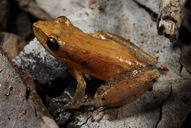|
Distribution and Habitat
Country distribution from AmphibiaWeb's database: Australia
Known in coastal Queensland, from northern to central Queensland. Also occur from Kimberley
region of Western Australia and the coast of the Northern Territory. May occur across all of
northern Australia in suitable habitat, but is extremely difficult to detect due to its tiny size
(16mm).
The extent of occurrence of the species is approximately 225400 km2
Life History, Abundance, Activity, and Special Behaviors
Occurs in wet regions. Often found among long grass surrounding swamps, marshy areas and
ponds. Also hides in tufts of low-growing grasses and beneath large rocks and logs.
Breeding occurs in summer when males call from vegetation up to 30cm off the ground. Spawn
clumps contain 60 small eggs, which are laid in shallow water in temporarily flooded areas.
Trends and Threats
No known declines and large extent of occurrence.
Threats
None known.
Conservation Measures
None in place.
References
Barker, J., Grigg, G. C., and Tyler, M. J. (1995). A Field Guide to Australian Frogs. Surrey Beatty and Sons, New South Wales.
Cogger, H.G. (1992). Reptiles and Amphibians of Australia. Reed Books, New South Wales.
Tyler, M.J., Crook, G.A., and Davies, M. (1983). ''Reproductive biology of the frogs of the Magela Creek System, Northern Territory.'' Records of the South Australian Museum, 18, 415-440.
Tyler, M.J., Smith, L.A., and Johnstone, R.E. (1994). Frogs of Western Australia. Western Australian Museum, Perth.
Originally submitted by: Jean-Marc Hero et. al. (first posted 2002-04-05)
Edited by: Ambika Sopory (2008-09-16)Species Account Citation: AmphibiaWeb 2008 Litoria microbelos: Javelin Frog <https://amphibiaweb.org/species/1274> University of California, Berkeley, CA, USA. Accessed May 22, 2025.
Feedback or comments about this page.
Citation: AmphibiaWeb. 2025. <https://amphibiaweb.org> University of California, Berkeley, CA, USA. Accessed 22 May 2025.
AmphibiaWeb's policy on data use.
|





 Map of Life
Map of Life